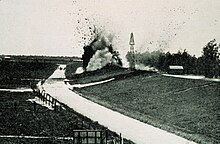Mississippi flood 1927
The Mississippi flood of 1927 was a flood of the century and represents the flood disaster with the most devastating effects in the history of the United States. At its height 700,000 people were evacuated and an area of 70,000 km² in the states of Arkansas , Illinois , Kentucky , Louisiana , Missouri , Mississippi and Tennessee flooded.
course
As early as the winter of 1926/27, the headwaters of the Mississippi in Kansas and Iowa fed themselves to their capacity limits as a result of heavy rainfall. On April 15, 1927, Good Friday , heavy and persistent rain showers began over the entire Mississippi Valley and the neighboring states. By May, the Mississippi had reached a width of up to 97 kilometers downstream from Memphis , Tennessee. To divert the flood from New Orleans , Louisiana, dams were blown up in St. Bernard Parish with the help of 30 tons of dynamite ; a measure that later turned out to be unnecessary because other dams upstream from New Orleans had broken and thus largely spared the city. It took until August for the floods to drain completely.
Effects
In politics and society
In 1928, the Flood Control Act was passed and the US armed forces were tasked with expanding the flood protection system, which resulted in the world's longest dam system. Politically, the flood helped the then Economics Minister Herbert Hoover in the administration under US President Calvin Coolidge to present himself to a nationwide audience for the first time as a crisis manager. The following year he ran for the presidency and was able to defeat his democratic opponent. During his presidency, however, details came to light of how badly the African Americans were treated in the evacue camps. Blacks had to build dikes at gunpoint, starved to death in the refugee camps and were not rescued, while only whites were taken care of. This cost Hoover much sympathy and not least contributed to his defeat in his re-candidacy in 1932 .
More than half of the population affected by the disaster were African American, and therefore the Flood was one of the factors that fueled the Great Migration of African Americans between 1915 and 1930. Before 1927, this migration from the rural south to the industrial cities on the Great Lakes and the northeastern United States had been reduced to a minimum.
In pop music
Culturally, the memory of the flood was reflected primarily in folk music and in the then emerging genre of delta blues . Artists like Kansas Joe and Memphis Minnie ( When the Levee Breaks ), Charley Patton ( High Water Everywhere ), Bessie Smith , Barbecue Bob and John Lee Hooker ( Tupelo , 1960) dealt with it.
The most famous song Louisiana 1927 by Randy Newman did not appear until 1974 on the concept album Good Old Boys . After Hurricane Katrina in 2005, Newman took it on again with orchestra accompaniment for the benefit of the disaster victims, whereupon the ballad became the unofficial anthem of the state of Louisiana.
See also
literature
- John M. Barry: Rising Tide. The Great Mississippi Flood of 1927 and How It Changed America . Simon & Schuster, New York NY 1997, ISBN 0-684-81046-8 .
Individual evidence
Web links
- Man vs. Nature: The Great Mississippi Flood - Article on National Geographic .


